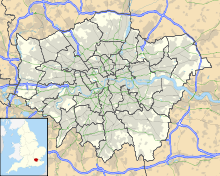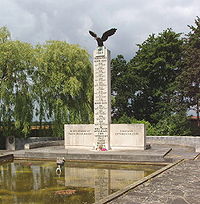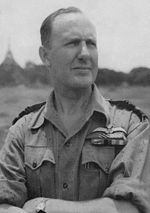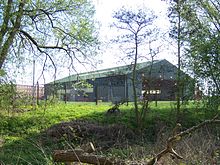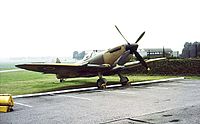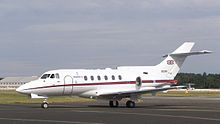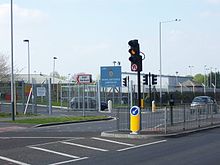- RAF Northolt
-
Royal Air Force Northolt 
Ready to carry or to fight IATA: NHT – ICAO: EGWU Summary Airport type Military Operator Royal Air Force Location Ruislip, Middlesex Occupants - No. 32 (The Royal) Squadron RAF
- No. 600 Squadron RAF
- 621 EOD Squadron RLC
- BFPO & Defence Courier Service
- Northolt Station Flight
Elevation AMSL 124 ft / 38 m Coordinates 51°33′11″N 000°25′06″W / 51.55306°N 0.41833°WCoordinates: 51°33′11″N 000°25′06″W / 51.55306°N 0.41833°W Website Map Location in Greater London Runways Direction Length Surface m ft 07/25 1,687 5,535 Grooved Asphalt Sources: UK AIP at NATS[1] RAF Northolt (IATA: NHT, ICAO: EGWU) is a Royal Air Force station situated in South Ruislip, 2 NM (3.7 km; 2.3 mi) east by northeast[1] of Uxbridge in the London Borough of Hillingdon, West London. Approximately 10 km (6.2 mi) north of London Heathrow Airport, the station also handles a large number of private civil flights.[2] Northolt has one runway in operation, spanning 1,687 × 46 m (5,535 × 151 ft), with a grooved asphalt surface.
Northolt pre-dates the establishment of the Royal Air Force by almost three years, having opened in May 1915. Originally established for the Royal Flying Corps, it has the longest history of continuous use of any RAF airfield. Before the outbreak of the Second World War, the station was the first to take delivery of the Hawker Hurricane. The station played a key role during the Battle of Britain, when fighters from several of its units, including No. 303 Polish Fighter Squadron, engaged enemy aircraft as part of the defence of London. It became the first base to have squadrons operating Supermarine Spitfire aircraft within German airspace.
During the construction of Heathrow Airport, Northolt was used for commercial civil flights, becoming the busiest airport in Europe for a time and a major base for British European Airways. More recently the station has become the hub of British military flying operations in the London area. Northolt has been extensively redeveloped since 2006 to accommodate these changes, becoming home to the British Forces Post Office, which moved to a newly constructed headquarters and sorting office on the site. RAF squadrons, including No. 32 (The Royal) Squadron are based at RAF Northolt; its location close to the A40 road link with central London has also made it popular with business people and politicians. The station has also been used as a filming location for productions made at Pinewood Studios.
Contents
History
Construction
Following Louis Blériot's first flight across the English Channel in 1909, the British Army considered the necessity of defending the United Kingdom from a future air attack. By May 1910, Claude Grahame-White and other aviation pioneers were flying from the flat areas around Ruislip, although they soon sought an aerodrome for London, which was eventually built at Hendon. A proposal was made in 1912 for the area around where RAF Northolt now stands to be developed as "Harrow Aerodrome". The company established to develop the site was listed on the London Stock Exchange but the idea did not progress any further.[3]
The assassination of Archduke Franz Ferdinand of Austria in 1914 and the ensuing outbreak of the First World War necessitated a new aerodrome for the Royal Flying Corps. The Corps had received the Royal Warrant on 13 April 1912, whereupon Major Sefton Brancker of the War Office conducted aerial surveys in 1914 of Glebe Farm in Ickenham, and Hundred Acres Farm and Down Barnes Farm in Ruislip, looking for the most effective operating base for new squadrons. He settled on a site near Northolt Junction railway station but it was not until January 1915 that the British government officially requisitioned the land. It is rumoured that the government official tasked with acquiring the land arrived at the site with his map upside down, leading to the government requisitioning and developing land on the wrong side of the railway line,[4] including the old Hill Farm.[5]
 Easterly view of the aerodrome in 1917
Easterly view of the aerodrome in 1917
Construction of the new aerodrome, to be named "RFC Military School, Ruislip", began in January 1915. It opened on 3 May 1915, becoming known as Northolt and home to No. 4 Reserve Aeroplane Squadron which relocated from Farnborough. The airfield became "Northolt" despite being situated in neighbouring South Ruislip. Most early RAF airfields were named after the nearest railway station, in this case South Ruislip station, known at that time as Northolt Junction and later Northolt Halt. In the same year the airfield was extended westwards and aircraft began flying sorties in defence of London against Zeppelin raids. No. 18 Squadron was formed in the same month as Northolt and equipped with Bleriot Experimental biplanes, whose slow speed led to heavy losses in combat with the German Air Force.[4]
In 1916, No. 43 Squadron was formed under the command of Major Sholto Douglas. Aircraft equipping the squadron included the Sopwith 1½ Strutter, built by the Fairey Aviation company, then situated in Hayes. The Strutter made its first test flight from Northolt in 1916 with Harry Hawker at the controls.[6] Fairey conducted test flights at Northolt from 1917 until 1928 when the Air Ministry gave the company notice to vacate the aerodrome.[7] Flights later resumed from the Great West Aerodrome owned by Fairey in Harmondsworth, which was eventually developed as Heathrow Airport.[8] No. 43 Squadron went on to fly sorties over France from 17 January 1917, taking part in the Battle of Vimy Ridge between 4 and 8 April 1917.[9]
No. 600 Squadron and No. 601 Squadron of the fledgling Royal Auxiliary Air Force were formed at Northolt in 1925 under the command of Squadron Leader Lord Edward Grosvenor. Both squadrons were deployed to RAF Hendon in 1927, although 600 Squadron would return in 1939. The Prince of Wales, later King Edward VIII and subsequently the Duke of Windsor, made his first flight in a Bristol F.2 Fighter from Northolt on 27 April 1929.[10]
Battle of Britain and the Second World War
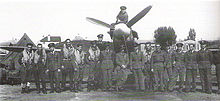 303 squadron pilots (May 1942, RAF Northolt)[a]
303 squadron pilots (May 1942, RAF Northolt)[a]
Northolt became an active base during the Second World War for Royal Air Force and Polish Air Force squadrons in their defence of the United Kingdom. It was the first RAF station to operate the Hawker Hurricane, with No. 111 Squadron receiving the first four aircraft in December 1937,[11] and reaching its full complement by February 1938.[12] In the lead-up to war, the RAF implemented a policy of adding concrete runways to important airfields. As a result, by 1939 Northolt had a new 800-by-50-yard (730 by 46 m) concrete runway.[13] Later in 1939 RAF Hendon became one of its satellite airfields.[14] Polish pilots were taught English at RAF Uxbridge, where they also practiced formation flying using tricycles with radios, compasses and speed indicators.[15]
On 15 September 1940 during the Battle of Britain, No. 1 Squadron RCAF, No. 229 Squadron, No. 303 Polish Fighter Squadron, No. 504 Squadron, and part of No. 264 Squadron were based at the station, all under the control of No. 11 Group RAF, headquartered at RAF Uxbridge.[12] All flew Hawker Hurricanes except No. 264 Squadron's contingent, which operated the Boulton Paul Defiant. During the Battle of Britain, the Polish Squadron downed the highest number of enemy aircraft with its Czech pilot Sergeant Josef Frantisek scoring the most "kills".[11] The Luftwaffe bombed the airfield in August 1940 as well as other sector airfields in the area, including Biggin Hill, Hornchurch and North Weald, as part of a concentrated effort against the airfields and sector stations of No. 11 Group RAF.[12] A total of 4,000 bombs were recorded as falling within two miles (3 km) of the airfield over a fifteen-month period, although only two were recorded as hitting the airfield itself.[16] Under the leadership of the Station Commander, Group Captain Stanley Vincent, the airfield was camouflaged to resemble civil housing. Vincent had been concerned that camouflaging the airfield as open land would look too suspicious from the air; Northolt was surrounded by housing and so a large open area would draw attention. A fake stream was painted across the main runway while the hangars were decorated to look like houses and gardens.[17] The result was so effective that pilots flying to Northolt from other airfields often struggled to find the airfield.[18]
Thirty Allied airmen including servicemen from Belgium, Canada, Czechoslovakia, New Zealand, Poland and the United Kingdom were killed flying from RAF Northolt during the Battle of Britain, of whom ten were Polish.[19] The Polish War Memorial dedicated to all Polish airmen who lost their lives during the Second World War stands near the southeastern corner of the airfield. Its name is also commemorated at the adjacent eponymous junction on Western Avenue.[20]
Squadrons based at RAF Northolt during the battle shot down a total of 148 Luftwaffe aircraft and damaged 52. A further 25 were claimed by pilots and recorded as "probables".[21] Group Captain Vincent became one of the few RAF airmen to shoot down an enemy aircraft in both World Wars. Vincent was a long-serving RAF man who had claimed an aerial victory over the Western Front in the First World War. By the time of the Battle of Britain he was too old for operational flying. Nevertheless, he took to the skies during one raid and succeeded in bringing down a German aircraft.[22]
After the Battle of Britain, the station remained a base for daytime fighter operations, with No. 302 Polish Fighter Squadron, No. 229 Squadron and No. 615 Squadron all arriving before 3 November 1940. No. 308 Polish Fighter Squadron and No. 306 Polish Fighter Squadron later joined No. 303 during 1941 to form the No. 1 Polish Fighter Wing. Polish Fighter Squadrons based at Northolt in 1942 took part in Operation Jubilee (the raid on Dieppe) on 19 August alongside Nos. 302 and 308 from nearby RAF Heston. Reconnaissance squadrons No. 16 Squadron and No. 140 Squadron operating Supermarine Spitfires and de Havilland Mosquitos moved to Northolt in 1944. No. 69 Squadron with their Vickers Wellingtons modified for photographic reconnaissance arrived later. All three reconnaissance squadrons were combined to form No. 34 (PR) Wing.[23]
In 1943, the station became the first to fly sorties using Supermarine Spitfire Mk IXs in German airspace in support of bomber operations.[24] On 25 March, RAF Ferry Command became RAF Transport Command and thereafter used Northolt as a London base for the transfer of new aircraft from factories to airfields. Runway 26/08 was extended in February that year to accommodate the larger transport aircraft required by the Command. Northolt continued as a Sector Fighter Station until February 1944. As a result of this and the new larger runway, the smaller 02/20 runway closed in April 1944.[25]
RAF Northolt became home to Prime Minister Winston Churchill's personal aircraft, a modified Douglas C-54 Skymaster, in June 1944. The aircraft was used to fly him to meetings with other Allied leaders.[26] Between 20 and 21 July 1944, a converted Consolidated B-24 Liberator bomber named "Marco Polo" made the first non-stop intercontinental flight, flying from London to Washington, DC, then returning to Northolt from La Guardia Airport within 18 hours. In November of the same year, an Avro York flew non-stop from Northolt to Cairo in 10 hours and 25 minutes. A new runway, 31/13, was surveyed the following month and built in March 1946.[27]
Post-war civil and military use
Starting in 1946 the airfield was used by civil aviation during the construction of nearby Heathrow Airport.[11] During this period, Northolt became a major base for British European Airways, which used the nearby Bourne School as its headquarters.[28] Other airlines including Aer Lingus, Alitalia, Scandinavian Airlines System and Swissair used the airfield for scheduled services across Europe.[28]
In December 1946, after taking off during a heavy snowstorm, a Douglas DC-3 operated by British European Airways, flying from Northolt to Glasgow, crashed onto the roof of a house in South Ruislip. All the crew and passengers escaped unharmed by climbing through the loft of the house and leaving via the front door.[29] No residents were injured, even though the owner of the house next door was standing at her front gate when the aircraft came down. The owners of the house had not moved in at the time of the crash as they were due to be married a few days later. The house was later named "Dakota Rest" after the Douglas DC-3's wartime operational name, and still stands today.[30]
During 1952 a total of 50,000 air movements were recorded per annum, making the airfield the busiest in Europe.[24] By then the only scheduled airlines were BEA and Aer Lingus. The RAF maintained a presence throughout its use by civil airlines, making it the longest continually used airfield in the history of the Royal Air Force.[29] En route from Northolt to Dublin, on 10 January 1952, a civil Douglas C-47 Skytrain operated by Aer Lingus and named "St. Kevin" flew into an area of extreme turbulence caused by a mountain wave generated by Snowdon. As a result, the plane crashed into a peat bog near Llyn Gwynant in Snowdonia, killing all 20 passengers and three crew in the company's first fatal accident.[31]
Civil flights ceased when the central area at Heathrow opened in 1954 with Northolt reverting to sole military use in May that year.[32] The much larger civil airport at Heathrow meant Northolt's operations became constrained by its proximity to the new facility.[33] No. 1 Aeronautical Information Documents Unit (AIDU) moved to the station in 1956 from the neighbouring RAF West Ruislip station.[11] The unit had been established in 1953 to provide information on airfields, communications and navigational aids for the benefit of aircraft safety. AIDU was originally under the command of RAF Transport Command but this was moved to Home Command in March 1957.[34]
On 1 June 1960, an Avro Anson aircraft suffered engine failure soon after take-off from Northolt and crash-landed on top of the nearby Express Dairies plant in South Ruislip. There were no fatalities.[33] Later that year, on 25 October, a Pan Am Boeing 707, heading for Heathrow, mistakenly landed at Northolt with forty-one passengers on board.[35][36] A Lufthansa Boeing 707 also attempted to land at the station on 28 April 1964 but was dissuaded by a red signal flare fired by personnel from Air Traffic Control. In the days before navigational aids such as instrument landing systems (ILS) and the global positioning system (GPS) were available, the letters NO (for Northolt) and LH (for Heathrow) were painted on two gasometers situated on the approach to each airfield, one at Southall for the approach to Heathrow's diagonal runway (coded 23L) and one at South Harrow for the approach to Northolt's runway (then coded 26), in an effort to prevent a recurrence of such errors.[33] By the 1980s movements of privately-owned aircraft, mainly corporate jets, outnumbered military aircraft. Civil flights were limited to 28 per day,[37] with a maximum of 7,000 a year. This limit remains to this day.[38]
Northolt received its first gate guardian, a Spitfire F.Mk 22, in September 1963. Purchased from the RAF in 1969 for use in the film Battle of Britain, it was replaced by a Spitfire Mk XVI on 2 June 1970. This aircraft remained at the station until its removal on 8 September 1989 for restoration to full flying condition. The Kermit Weeks' Fantasy of Flight Museum in Polk City, Florida, purchased the aircraft whereupon the station received a fibreglass replica of a Spitfire Mk IX as a replacement.[39]
Servicing of No. 32 Squadron passed from the RAF to the private company Fields Aviation Services in April 1985, then to Lovaux Aircraft Servicing in 1990. In 1991, the Station Flight was established, taking delivery of two Britten-Norman Islanders in December which entered service in January 1992.[40] No. 32 Squadron celebrated its Diamond Jubilee in 1991, at a time when personnel became involved in operations during the Gulf War. No. 38 Group RAF assumed control of RAF Northolt on 2 November 1992 following a wider restructuring of the RAF. On 16 December 1994, the new southside Operations Building opened, replacing the old Northolt Airport Terminal building. With the reorganisation of RAF Strike Command on 1 April 2000, No. 38 Group was disbanded and Northolt came under the control of No. 2 Group RAF.[41]
In August 1996, a Spanish Learjet operated by Mar Aviation overshot runway 25 and collided with a van heading eastward on the A40 Western Avenue; the aircraft was carrying an actress bound for Pinewood Studios in Buckinghamshire. The two pilots, the actress and van driver all suffered minor injuries.[42] The ensuing investigation by the Civil Aviation Authority's Air Accidents Investigation Branch found that both the crew's lack of understanding English and military air traffic control procedures had contributed significantly to the crash. Subsequently, after some thirty years of protracted consideration, an ILS was eventually fitted to Northolt's redefined Runway 25. In addition, aggregate-filled safety pits were installed at each end of the runway by 21 January 1998 to protect road users in the event of another business jet or military transport failing to stop or ascend before the end of the runway.[43] The House of Commons Transport Select Committee considered the conversion of RAF Northolt to a possible offshoot of Heathrow Airport in the 1990s. While the existing runways would cause aircraft to cross the flightpaths of those using Heathrow, new parallel runways were suggested.[44] These suggestions were opposed by then MP for Ruislip-Northwood, John Wilkinson, and eventually progressed no further.[45]
Much media attention focused on the airfield when the body of Diana, Princess of Wales, arrived there from Villacoublay airfield, in Paris, France, after her death in a car crash in the city on 31 August 1997.[46] The Queen's Colour Squadron, then based at neighbouring RAF Uxbridge, acted as the bearer party, while the flight was met by the Prime Minister, the Lord Chamberlain, Lord Lieutenant of Greater London, Secretary of State for Defence, the RAF Northolt Station Commander and the RAF Chaplain-in-Chief.[47]
Attention was high again in 2001, when the seriously ill, fugitive Great Train Robber, Ronnie Biggs was flown from Brazil to the airfield to be arrested by waiting police officers. Biggs had escaped from custody in 1965 and was taken to Belmarsh Prison, upon his return, to complete the remainder of his sentence.[48]
Since 1 June 1998, station commanders have served as aides-de-camp to Her Majesty the Queen.[49] The station received the Freedom of Entry to the London Borough of Hillingdon on 11 May 2000. This allowed military personnel to march through the borough in full uniform, an honour granted by the council in light of 2000 being the 60th anniversary of the Battle of Britain and the 85th anniversary of the opening of RAF Northolt. The neighbouring RAF Uxbridge station had received the same honour in 1960.[50]
The remains of a Hawker Hurricane flown by Flying Officer Ludwik Witold Paszkiewicz, the first pilot in No. 303 Squadron to shoot down an enemy aircraft, were donated to the station in June 2008. During the Battle of Britain, Paszkiewicz became a flying ace and received the Distinguished Flying Cross after shooting down six aircraft. He was killed in action over Borough Green in Kent on 27 September 1940.[51] No. 303 Squadron recorded its 100th kill less than a month after commencing operations.[52] Polish pilot Squadron Leader Franciszek Kornicki, who saw wartime service at RAF Northolt, was reunited with the Supermarine Spitfire he had flown at a special ceremony in September 2010.[53]
An additional memorial to British, Polish, Australian and New Zealand aircrew killed during the Battle of Britain was unveiled in September 2010.[54] In October that year, the hangar which had housed Churchill's personal aircraft, the former Squadron Watch office and the Operations Block were given Grade II listed building status.[55] The Operations Block was a prototype of the "Dowding System", which facilitated the chain of command's issuance of orders for the interception of enemy aircraft and a scheme used for the first time during the Battle of Britain. Prior to the listing, the block was renamed the Sir Keith Park Building on 20 September in honour of the former No. 11 Group RAF commander who had also served as Station Commander at Northolt between 1931 and 1932.[56] RAF Northolt itself is the only airfield in use during the Battle of Britain still operated by the RAF.[57]
Group Captain Tom Barrett, appointed Station Commander in September 2009[58] and the final Station Commander of neighbouring RAF Uxbridge,[59] died on 10 March 2011 following a road traffic accident on the A40.[60] Wing Commander Jules Stilwell paid tribute to Group Captain Barrett, saying, "Tom was an extraordinary person. We were privileged to have had him as our station commander and the Royal Air Force is a poorer place without him."[61] Group Captain Tim O'Brien was appointed Group Captain Barrett's successor in May 2011.[62]
Project MoDEL redevelopment
The Ministry of Defence launched Project MoDEL (Ministry of Defence Estates London) in 2006 to consolidate many of its London-based operations at RAF Northolt. Under the project, RAF Bentley Priory,[63] RAF Uxbridge,[59] RAF West Ruislip,[64] RAF Eastcote[65] and the Inglis Barracks in Mill Hill were all closed between 2006 and 2010 with any remaining units transferring to Northolt.[59] The Air Historical Branch, originally established in 1919 to provide a record of air activity during the First World War, was also relocated to RAF Northolt from RAF Bentley Priory in 2008 as part of this project.[66] As a result, the station has been extensively redeveloped with new facilities to support these operations.[67]
The statue, Letter from Home, of a First World War soldier reading a letter was moved from outside Inglis Barracks in Mill Hill to RAF Northolt in June 2007. It is a replica of the statue at Paddington Station and was first unveiled in 1982.[68] Following the relocation of the British Forces Post Office and Defence Courier Service from Mill Hill,[69] a new headquarters and main sorting facility were built for their use which opened in November 2007.[70] New hangar facilities for the use of No. 32 Squadron were also constructed, along with new personnel accommodation.[71]
Refurbishment of the original 1920s Officers' Mess took place in collaboration with English Heritage and reopened in June 2009.[72] Further work at the station saw the relocation of the Supermarine Spitfire (full scale replica) gate guardian to the passenger terminal, and the unveiling of a new Hawker Hurricane (full scale replica) gate guardian near the eastern station entrance in September 2010, commemorating the aircrew based at Northolt who had fought in the Battle of Britain.[73]
Upon the closure of RAF Uxbridge, control of the Battle of Britain Bunker passed to RAF Northolt to allow for continued public visits.[74] In December 2010 it was agreed that the South Hillingdon branch of the St. John Ambulance service would move from its existing base in RAF Uxbridge to new premises at Northolt.[75]
Operations
Within the Operations Wing, the station houses No. 32 (The Royal) Squadron RAF, No. 600 Squadron (Royal Auxiliary Air Force), 621 EOD Squadron RLC (part of 11 Explosive Ordnance Disposal Regiment) and the Royal Logistic Corps.[76] 32 Squadron flies six BAe 125 CC.3 executive jets, two BAe 146 CC.2 four-engine VIP short range transport aircraft, and two Agusta Westland A109E Power helicopters.[77] RAF Northolt also houses the Station Flight, operating three Britten-Norman Islanders in electronic intelligence gathering – described by the RAF as performing "photographic mapping and light communications roles".[77]
The Support Wing of the station incorporates the Administrative Squadron, the Plans and Business Squadron, the Engineering Squadron and the Finance Department. Its Operations Squadron, the Air Movements Squadron and the Airfield Support Squadron make up the station's Operations Wing. Lodger Units at Northolt include No. 32 (The Royal) Squadron RAF, No. 600 Squadron Royal Auxiliary Air Force, No. 1 AIDU (Aeronautical Information Documents Unit), the Service Prosecuting Authority, Naval Aeronautical Information Centre, 621 Explosive Ordnance Disposal (EOD) Squadron, the British Forces Post Office (BFPO), the Air Historical Branch (AHB) and the Military Aviation Authority.[76]
Squadrons and aircraft
Sources: Battle of Britain Airfields (1st Edition)[78] and A History of Royal Air Force Northolt[79]
Unit Dates Aircraft Variant Notes No. 1 Squadron RAF August–September 1940 Hawker Hurricane I No. 1 Squadron RCAF August–October 1940 Hawker Hurricane I Renumbered No. 401 Squadron RCAF in 1941 No. 4 Squadron RAF February–September 1919 Royal Aircraft Factory RE 8 Returned from operations in France as a cadre No. 12 Squadron RAF April 1923 – March 1924 De Havilland DH.9A Formed at Northolt then moved to RAF Andover No. 16 Squadron RAF April–September 1944 Supermarine Spitfire XI and XI Moved out to Normandy, France No. 18 Squadron RFC May–August 1915 Various Formed at Northolt then moved to Mousehold No. 23 Squadron RAF December 1936 – May 1938 Hawker Demon No. 24 Squadron RAF January 1927 – February 1933 Variety of types Operated eight different types of aircraft for communications and liaison duties No. 25 Squadron RAF September 1938 – October 1938 Gloster Gladiator I No. 32 Squadron RAF February 1969 – Percival Pembroke
Bristol Sycamore
Beagle Basset
Hawker Siddeley Andover
Westland Whirlwind
British Aerospace 125
Westland Gazelle
BAe 146Communications and liaison duties No. 41 Squadron RAF April 1923 – October 1935 Variety of types Moved to Aden operating the Hawker Demon No. 43 Squadron RAF May–September 1940 Hawker Hurricane I Not based but operated detachments from RAF Tangmere No. 65 Squadron RAF October 1939 – March 1940 Supermarine Spitfire I No. 69 Squadron RAF May–September 1944 Vickers Wellington XIII Moved out to Normandy, France No. 111 Squadron RAF July 1934 – October 1939 Bristol Bulldog
Gloster Gauntlet
Hawker HurricaneNo. 124 Squadron RAF July–September 1943 Supermarine Spitfire VII No. 140 Squadron RAF April–September 1944 De Havilland Mosquito IX and XVI Moved out to Normandy, France No. 207 Squadron RAF February 1969 – June 1984 Beagle Basset
Hunting Pembroke
De Havilland DevonCommunication and liaison squadron No. 213 Squadron RAF March 1937 – July 1937 Gloster Gauntlet II No. 229 Squadron RAF September–December 1940 Hawker Hurricane I No. 253 Squadron RAF February–May 1940 Hawker Hurricane I No. 257 Squadron RAF July–August 1940 Hawker Hurricane I No. 264 Squadron RAF August–October 1940 Hawker Hurricane I No. 302 Polish Fighter Squadron October–November 1940
December 1943 – March 1944Hawker Hurricane I Polish-manned unit No. 303 Polish Fighter Squadron January–July 1941 Supermarine Spitfire I, IIA and IIB Polish-manned unit No. 306 Polish Fighter Squadron April–October 1941 Hawker Hurricane
Supermarine SpitfireJune 1942 – March 1943 Supermarine Spitfire VB then IX Polish-manned unit No. 308 Polish Fighter Squadron October–December 1943 Supermarine Spitfire IIA Polish-manned unit No. 315 Polish Fighter Squadron July 1941 – April 1942 Supermarine Spitfire IIA, IIB and VB Polish-manned unit No. 316 Polish Fighter Squadron December–April 1942
March–September 1943Supermarine Spitfire VB Polish-manned unit No. 317 Polish Fighter Squadron April–June 1942
July–September 1942
September–December 1943Supermarine Spitfire VB then IX Polish-manned unit No. 515 Squadron RAF October 1942 Boulton Paul Defiant II Formed then moved to Heston No. 600 Squadron RAF October 1925 – January 1927 De Havilland DH.9A Formed at Northolt August–October 1939
May–June 1940Bristol Blenheim I No. 601 Squadron RAF October 1925 – January 1927 De Havilland DH.9A Formed at Northolt December 1940 – May 1941 Hawker Hurricane I, II No. 604 Squadron RAF January–May 1940 Bristol Blenheim I June–July 1940 Gloster Gladiator I No. 609 Squadron RAF May–July 1940 Supermarine Spitfire I No. 615 Squadron RAF October–December 1940 Hawker Hurricane I In popular culture
Due to its proximity to several film studios including those at Pinewood, the airfield has been used to represent outside locations in a number of feature films. The James Bond films Goldfinger, Thunderball and Octopussy were filmed at Northolt, and station personnel served as extras in the Octopussy hangar fly-through stunt scene.[80] The mini-series The Winds of War and The Bill and the BBC shows Waking the Dead, Doctor Who and Red Dwarf have all used Northolt to represent various fictional airfields.[80] In early 2010 the station was used for the filming of the BBC's final series of Ashes to Ashes.[81]
See also
- Kennedy Giant
- List of Battle of Britain airfields
- List of RAF stations
References
Listen to this article (info/dl)
This audio file was created from a revision of RAF Northolt dated 2006-03-31, and does not reflect subsequent edits to the article. (Audio help)More spoken articles- Notes
- a ^ Appearing in photograph, L-R: Sgt. Stasik, P/O Socha, P/O Kolecki, F/O Lipiński, F/O Horbaczewski, F/O Schmidt, F/Sgt Giermar (on the wing), Flt Lt Zumbach, Sqn Ldr Kołaczewski, Flt Lt Żak, F/Sgt Popek, F/O Bieńkowski, F/O Kłosin, F/O Kolubiński, F/Sgt Karczmarz, F/Sgt Sochacki, F/Sgt Wojciechowski and on the propeller F/O Głowacki.
- Citations
- ^ a b "Northolt – EGWU". National Air Traffic Services. http://www.nats-uk.ead-it.com/public/index.php%3Foption=com_content&task=blogcategory&id=107&Itemid=156.html. Retrieved 4 May 2011.
- ^ "RAF Northolt – About us". Royal Air Force. 2011. http://www.raf.mod.uk/rafnortholt/aboutus/. Retrieved 19 April 2011.
- ^ Bristow 2005, p.13
- ^ a b Bristow 2005, p.16
- ^ Bowlt 1996, p.70
- ^ Bristow 2005, p.20
- ^ Sherwood 1990, p.22
- ^ Bristow 2005, p32
- ^ Bristow 2005, p.21
- ^ Bristow 2005, p.41
- ^ a b c d "RAF Northolt – History of RAF Northolt". Royal Air Force. 2011. http://www.raf.mod.uk/rafnortholt/aboutus/history.cfm. Retrieved 18 April 2011.
- ^ a b c Townsend Bickers 1990, p.45
- ^ Birtles 2010, p.37
- ^ Birtles 2010, p.58
- ^ Bristow 2005, p.58
- ^ Edwards 1987, p.69
- ^ Bowlt 1994, p.132
- ^ Bristow 2005, p.52
- ^ Bristow 2005, p.7
- ^ "Polish War Memorial". London Borough of Ealing. http://www2.ealing.gov.uk/services/leisure/local_history/historic_buildings/polish_war_memorial.html. Retrieved 8 March 2011.
- ^ Bristow 2005, p.67
- ^ Birtles 2010, pp.50–51
- ^ Bristow 2005, p.72
- ^ a b Thompson, Pete (2008). "RAF Northolt Visit – 22nd October 2008". On Target Aviation. http://on-target-aviation.com/RAF%20Northolt%2008.html. Retrieved 13 March 2011.
- ^ Bristow 2005, pp. 71–72
- ^ Bristow 2005, p.74
- ^ Bristow 2005, p.75
- ^ a b Bristow 2005, p.77
- ^ a b Bristow 2005, p.79
- ^ Bowlt 1994, pp.130–132
- ^ "10 Jan 1952 Douglas C-47B-35-DK Dakota 3." Aviation Safety Network. Retrieved 3 February 2009.
- ^ Bristow 2005, p.80
- ^ a b c Bristow 2005, p.90
- ^ Bristow 2005, p.85
- ^ Trussell, George (25 October 1960). "Boeing 707–321, N725PA, Pan American World Airways (PA / PAA)". George Trussell Collection. http://www.abpic.co.uk/photo/1001607/. Retrieved 10 March 2011.
- ^ Bristow 2005, p.89
- ^ "RAF Northolt". London Borough of Hillingdon. 17 May 2010. http://www.hillingdon.gov.uk/index.jsp?articleid=16412. Retrieved 8 March 2011.
- ^ "House of Lords Written Answers: RAF Northolt". Hansard. 11 December 2008. http://services.parliament.uk/hansard/Lords/ByDate/20081211/writtenanswers/part007.html. Retrieved 8 March 2011.
- ^ Bristow 2005, p.108
- ^ Bristow 2005, p.99
- ^ Bristow 2005, p.102
- ^ Longhurst, Chris; Fisher, Barbara; Berry, Chris (16 June 2008). "When the Learjet came down it really was a case of 'hold the front page'". Uxbridge Gazette. http://www.uxbridgegazette.co.uk/west-london-news/uxbridge-history/2008/06/16/when-the-learjet-came-down-it-really-was-a-case-of-hold-the-front-page-113046-21082526/. Retrieved 15 September 2010.
- ^ Bristow 2005, p.107
- ^ "RAF Northolt". Hansard. 30 June 1998. http://hansard.millbanksystems.com/commons/1998/jun/30/raf-northolt. Retrieved 15 September 2010.
- ^ "Britain's airports battle for passengers, airlines ... and survival". Centre for Asia Pacific Aviation. 11 February 2011. http://www.centreforaviation.com/news/2011/02/11/britains-endangered-airports/page1. Retrieved 8 March 2011.
- ^ "Diana, Princess of Wales". The Royal Household. http://www.royal.gov.uk/HistoryoftheMonarchy/The%20House%20of%20Windsor%20from%201952/DianaPrincessofWales/Death.aspx. Retrieved 15 September 2010.
- ^ Bristow 2005, p.92
- ^ "Biggs sent back to jail". BBC News. 7 May 2001. http://news.bbc.co.uk/1/hi/uk/1316917.stm. Retrieved 8 May 2011.
- ^ Bristow 2005, p.93
- ^ Bristow 2005, p.121
- ^ Longhurst, Chris (16 June 2008). "Hurricane Mk1 No L1696 back at RAF Northolt". Uxbridge Gazette. http://www.uxbridgegazette.co.uk/west-london-news/uxbridge-history/2008/06/16/hurricane-mk1-no-l1696-back-at-raf-northolt-113046-21082933/. Retrieved 8 March 2011.
- ^ Sweeting, Adam. "Bloody Foreigners: The Untold Battle of Britain, Channel 4". The Arts Desk. http://www.theartsdesk.com/index.php?option=com_k2&view=item&id=1755:bloody-foreigners-untold-battle-of-britain-c4&Itemid=31. Retrieved 13 March 2011.
- ^ "Battle of Britain veteran Franciszek Kornicki reunited with spitfire at RAF Northolt". Hillingdon Times. 21 September 2010. http://www.times-series.co.uk/news/battle/8405178.Battle_of_Britain_veteran_reunited_with_spitfire/. Retrieved 8 March 2011.
- ^ "RAF Northolt". Coulon Stone. 11 February 2011. http://www.coulonstone.com/memorials/raf-northolt. Retrieved 13 March 2011.
- ^ "Key buildings at RAF Northolt listed". Department for Culture, Media and Sport. 28 October 2010. http://www.culture.gov.uk/news/news_stories/7521.aspx. Retrieved 7 March 2011.
- ^ "Sir Keith Park Building formally opens at RAF Northolt". Hillingdon & Uxbridge Times. 20 September 2010. http://www.hillingdontimes.co.uk/news/localnews/8402642.Sir_Keith_Park_Building_formally_opens/?ref=rss. Retrieved 2 June 2011.
- ^ Bristow, Mark (8 September 2006). "It was both the RAF and the Navy who halted the German invasion". Comment is free. The Guardian. http://www.guardian.co.uk/commentisfree/2006/sep/08/comment.secondworldwar. Retrieved 22 July 2011.
- ^ "Group Captain Tom Barrett". The Telegraph. 20 March 2011. http://www.telegraph.co.uk/news/obituaries/military-obituaries/air-force-obituaries/8393882/Group-Captain-Tom-Barrett.html. Retrieved 30 May 2011.
- ^ a b c "Farewell to RAF Uxbridge". RAF News. 9 April 2010. http://www.rafnews.co.uk/readstory.asp?storyID=532. Retrieved 11 March 2011.
- ^ "Group Captain Tom Barrett: Biography". Hillingdon Times. 11 March 2011. http://www.hillingdontimes.co.uk/news/8905450.Group_Captain_Tom_Barrett__Biography/?ref=rss. Retrieved 11 March 2011.
- ^ "Tributes to RAF Northolt Station Commander after tragic accident". Hillingdon Times. 11 March 2011. http://www.hillingdontimes.co.uk/news/8905386.Tributes_paid_to_Group_Captain_Tom_Barrett/. Retrieved 11 March 2011.
- ^ "New Commander for RAF Northolt: Group Captain T J O'Brien". Ruislip Residents' Association. 30 April 2011. http://ruislipresidents.org.uk/raf-northolt/new-commander-for-raf-northolt-group-captain-t-j-o-brien.html. Retrieved 29 May 2011.
- ^ "Battle of Britain RAF base closed". BBC News. 30 May 2008. http://news.bbc.co.uk/1/hi/england/london/7428386.stm. Retrieved 30 May 2011.
- ^ "Eye on the fleet". Navy News Service. 28 September 2006. http://www.navy.mil/view_single.asp?id=39539. Retrieved 5 March 2011.
- ^ "RAF Eastcote". VSM Estates. http://www.vsmestates.co.uk/schemes_eastcote.htm. Retrieved 14 September 2010.
- ^ Sarbout, Nadia (24 July 2007). "Closing ceremony for Bentley Priory". Harrow Times. http://www.harrowtimes.co.uk/news/1566901.closing_ceremony_for_bentley_priory/. Retrieved 9 March 2011.
- ^ "RAF Northolt". VSM Estates. http://www.vsmestates.co.uk/schemes_northolt.htm. Retrieved 14 September 2010.
- ^ Sharp, Rachel (20 June 2007). "First posting for Northolt". Hillingdon & Uxbridge Times. http://www.hillingdontimes.co.uk/news/1486414.first_posting_for_northolt/. Retrieved 8 June 2011.
- ^ "Description of Site and Proposed Development". Mill Hill East. http://www.millhill-east.co.uk/documents/planning%20application%5CMHEOPA13%20Envionmental%20Statement/3%20Description%20of%20Site%20and%20Proposed%20Development.pdf. Retrieved 14 September 2010. ""Until recently, the principal role of the Inglis Barracks site has been as the headquarters of the British Forces Post Office (BFPO) and the Defence Courier Service (DCS). These activities have now been relocated to RAF Northolt and the site has closed.""
- ^ "History of the BFPO". Ministry of Defence. 5 January 2011. http://www.bfpo.mod.uk/aboutbfpo.htm. Retrieved 30 May 2011.
- ^ "RAF Northolt, Middlesex". MJN Colston. 2009. http://www.mjncolston.co.uk/projects/view/113. Retrieved 8 March 2011.
- ^ Mitchell, Charlene (23 June 2009). "RAF Northolt celebrates re-opening of Officers' Mess". Uxbridge Gazette. http://ruislip.uxbridgegazette.co.uk/2009/06/raf-northolt-celebrates-re-ope.html. Retrieved 13 March 2011.
- ^ Gray, Andrew (22 September 2010). "RAF Northolt unveils their new Hurricane Gate guardian". Uxbridge Gazette. http://www.uxbridgegazette.co.uk/west-london-videos-pics/west-london-picture-galleries/2010/09/22/raf-northolt-unveils-their-new-hurricane-gate-guardian-113046-27320262/. Retrieved 20 April 2011.
- ^ "Refurbished Spitfire Gate Guardian Unveiled at 11 Group Bunker". Royal Air Force. http://www.raf.mod.uk/rafnortholt/newsweather/index.cfm?storyid=237E237C-5056-A318-A8414AA43AE12B42. Retrieved 6 June 2011.
- ^ Coombs, Dan (8 December 2010). "New base for St John ambulance after our appeal". Uxbridge Gazette. http://www.uxbridgegazette.co.uk/west-london-news/local-uxbridge-news/2010/12/08/new-base-for-st-john-ambulance-after-our-appeal-113046-27784776/. Retrieved 8 June 2011.
- ^ a b "RAF Northolt – Who is based here?". Royal Air Force. 2011. http://www.raf.mod.uk/rafnortholt/aboutus/who_here.cfm. Retrieved 27 May 2011.
- ^ a b "Aircraft and Equipment". Royal Air Force. 2011. http://www.raf.mod.uk/rafnortholt/aboutus/aircraft_equipment.cfm. Retrieved 7 March 2011.
- ^ Jefford 1988, p.169
- ^ Bristow 2005, pp.8–9
- ^ a b Bristow 2005, p.101
- ^ Neville, Martin (21 May 2010). "The IW might be **** but its car is a star in finale". Isle of Wight County Press. http://www.iwcp.co.uk/news/news/the-iw-might-be-but-its-car-is-a-star-in-finale-32929.aspx. Retrieved 14 September 2010.
- Bibliography
- Birtles, Philip. (2010) Battle of Britain Airfields. London: Midland Publishing. ISBN 978-1-85780-328-0
- Bowlt, Eileen, M. (1994) Ruislip Past. London: Historical Publications ISBN 0-948667-29-X
- Bowlt, Eileen. M. (1996) Ickenham and Harefield Past. London: Historical Publications ISBN 0-948667-36-2
- Bristow, Mark. (2005) A History of Royal Air Force Northolt. RAF Northolt: No. 1 AIDU
- Edwards, Ron. (1987) Eastcote: From Village to Suburb. Uxbridge: London Borough of Hillingdon ISBN 0-907869-09-2
- Jefford, C. G. (1988) Battle of Britain Airfields (1st ed.) Shrewsbury: Airlife Publishing ISBN 1-85310-053-6
- Sherwood, Philip. (1990) The History of Heathrow. Uxbridge: London Borough of Hillingdon ISBN 0-907869-27-0
- Townsend Bickers, Richard. (1990) The Battle of Britain. London: Salamander Books ISBN 0-86101-477-4
Further reading
- Halpenny, Bruce Barrymore. (1984) Action Stations: Military Airfields of Greater London v. 8. London: Patrick Stephens ISBN 0-85059-585-1
- Halpenny, Bruce Barrymore. (1986) Fight for the Sky: Stories of Wartime Fighter Pilots. London: Patrick Stephens ISBN 0-85059-749-8
- Halpenny, Bruce Barrymore. (2004) Fighter Pilots in World War II: True Stories of Frontline Air Combat. London: Leo Cooper ISBN 1-84415-065-8
External links
- Official website
- Detailed historic record about RAF Northolt
- Detailed historic record about RAF Northolt Officers Mess
- British fighter pilot David Crook in his Spitfire, RAF Northolt, July 1940
- BAe 125 in hangar at RAF Northolt
Formations and units Commands · Groups · Stations · Wings · Aircraft squadrons · Aircraft flights · Conversion units · Regiment squadrons

Branches and components RAF Regiment · RAF Chaplains Branch · RAF Intelligence · RAF Legal Branch · Princess Mary's RAF Nursing Service · RAF Police · Search and Rescue Force · Mountain Rescue Service
Reserve forces Associated civil organizations Air Training Corps · RAF Association · RAF Centre of Aviation Medicine
Equipment List of RAF aircraft · List of RAF missiles
Personnel Symbols and uniform Public London Heathrow Airport · Gatwick Airport · London Stansted Airport · London Luton Airport · London City Airport · London Southend AirportMilitary RAF NortholtPrivate Categories:- 1915 establishments in the United Kingdom
- Airports in the London region
- Battle of Britain
- Buildings and structures in Hillingdon
- London Borough of Hillingdon
- Royal Air Force stations in England
- Royal Air Force stations in London
- Royal Flying Corps airfields
- Serco
- Transport in Hillingdon
Wikimedia Foundation. 2010.

